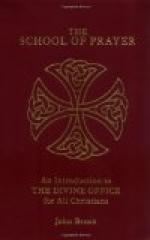The end and object of the Office are to invite us to join in the infinite praise which the Son of God rendered to His Father during His life, and which He renders still in Heaven and in the Tabernacle. “Domine in unione illius divinae intentionis qua ipse in terris laudes Deo persolvisti, has tibi Horas persolvo,” “O Lord, in union with that divine intention wherewith Thou whilst here on earth Thyself didst praise God, I offer these Hours to Thee.” The life of Christ is divided into four principal divisions: first, His birth, circumcision, epiphany, presentation; second, His public life and His death; third, His resurrection, ascension, and descent of the Holy Ghost; fourth, His mystic life in the Church and in Heaven. Hence arise the four general divisions of the Divine Office:—
First General Division which begins the Church’s year. From Advent to Septuagesima:—The birth of the Saviour preceded by His life in Mary’s womb, and by the four weeks of Advent, representing (it is said) the passing of the four thousand years, and embracing the mysteries of the Holy Infancy, Circumcision, Epiphany, Holy Name of Jesus, and the Presentation.
Second General Division, from Septuagesima till Easter:—The death of Christ preceded by the events of His public life, His fasting, temptation, preaching, miracles, passion and death.
Third General Division, from Easter to Pentecost:—The Resurrection, the Ascension, Pentecost.
Fourth General Division, from Pentecost till Advent, the termination of the Church’s year. The mystic life of Christ in the Church, which will end on the Judgment Day.
These divisions make up the four parts of the Roman Breviary.
The first part, Pars Prima, contains the Pontifical Bull, Quod a nobis, of Pope Pius V. (1568). It states:—1. That the cause of the new edition was to remove the regrettable variety in the public liturgy. 2. It recalls the labours of Pope Paul IV., Pius IV., and Pius V. for the same end. 3. It announces the abolition of the too-abbreviated Breviary of Quignonez and of all those which have not, for two hundred years preceding 1568, an authentic approbation or a lawful custom. 4. It gives permission to those using such breviaries to adopt the Roman Breviary. 5. It withdraws all privileges in respect to other breviaries. 6. It declares the Roman Breviary obligatory on all except those mentioned (vide 3, supra). 7. Even bishops are forbidden to make the smallest change in the new Breviary. 8. The recitation of offices from other breviaries does not fulfil the obligation of those bound to breviary recitation. 9. Bishops are requested to introduce the new Breviary. 10. The Pope suppressed the obligation of reciting on certain days the little Office of the Blessed Virgin, the Office of the Dead, the Penitential and the Gradual Psalms, 11. But he recommends their recitation on certain fixed days and




